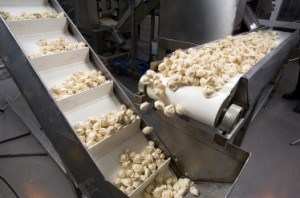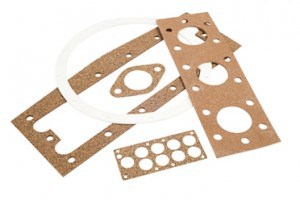Types of Gaskets
What Are the Different Types of Gaskets?
The most common types of gaskets are:
- Gaskets used in piping (flange gaskets)
- Gaskets used in vehicles (cars, boats, planes, trains etc.)
- Gaskets with certain material properties (cork, rubber paper etc.)
- Gaskets used for a particular function (for pressure, temperature or chemical resistance)
- Bespoke or custom made gaskets
Gasket Types and Uses
Gaskets can be classified in many different ways, for example: by material, by function, or by application. A gasket is basically a part cut from a (usually) flexible material, which sits in between two other surfaces. Gaskets are typically manufactured from soft materials (such as rubber); one of the most common uses is for sealing pipes to prevent the leakage of liquids. Gaskets also have certain other common applications, such as anti vibration and mounting.
Gasket Types by Material
Gaskets will inherit the properties of the materials from which they are manufactured. Gasket materials are used because of their resistance to certain chemicals (such as acids) or properties of being capable of withstanding extreme temperatures or pressures.
Common types of gaskets include:
Rubber Gaskets
Rubber is a soft gasket material. A wide range of elastomers can be used, such as neoprene, nitrile, EPDM and natural rubber. Rubber gaskets are used in a wide range of applications such as pipe gaskets, heat exchangers, and manways.
Non-Asbestos Gaskets
Non-asbestos gaskets are manufactured from a compressed fibre with an elastomer binding; and are used in many applications such as acid, steam, oil and water.
Cork Gaskets
Natural cork combined with elastomer bindings giving high flexibility and compression. These gaskets are widely used in applications involving oil, fuel and solvents.
Gasket Uses

Gaskets can also be grouped into different types by their functions, or uses. Some of the most common uses of gaskets are as follows:
Sealing
Liquid Seals
One of the main functions of a gasket is to seal against the leak or ingress of liquids. The rubber in liquid seals should be specified to the liquids used in the process. Certain rubber types offer better resistance to chemicals, such as viton, whereas nitrile is more suited to industries involving oils, fuels and solvents.
Environmental Seals
Environmental seals guard against dust and other environmental contaminants. These seals are used in enclosures, such as electrical enclosures. Enclosures the world over have requirements for access for maintenance. Generally, these enclosures contain control equipment that is essential to the operation of the installation that they are linked to.
A foam rubber door gasket fitted to these enclosures play an important part in keeping the integrity of the enclosure and ensuring the equipment inside is kept in an optimum working environment.
Anti Vibration
Vibration, as with sound, has frequencies. Anti-vibration pads or flooring are a way of disrupting those frequencies and reducing the amount of energy wasted or damage caused by vibration.
Anti-vibration methods are used in area such as machinery mountings, pipe supports or structural bearings.
Mountings
With technology today involving more digital displays to provide information, equipment manufacturers need to protect the sensitive display units from shock, ingress of dust or other particles that may include liquids.
Electrical switchgear also involves the providing of information via displays and typically can require access panels that need gaskets to ensure integrity of protective ratings.
Types of Gaskets in Piping & Flanges

Pipe gaskets (otherwise known as flange gaskets) are made from wide range of materials such as rubber, non-asbestos and graphite. The gaskets can be bought as either Full Faced (with bolt holes) or Inner Bolt Circle (IBC, ring type or raised face). We hold dedicated tooling for all gasket tables such as:
| BS10 Tables | A | D | E | ||
| EN1092-1 | PN6 | PN10 | PN16 | PN25 | PN40 |
| ASME/ANSI B16.5 | Class 150 | Class 300 | Class 600 | Class 900 | Class 2500 |
Full Faced
A Full Face gasket is one that covers the whole of the flange. It will be easily recognised by the fact that the holes for the bolts to pass through are cut into the gasket material.
IBC (Inner Bolt Circle)
Inner Bolt Circle gaskets (IBC) are also known as ring type or raised face. They sit within the circle of the bolts used to secure the joint and are purely a continuous ring of material.
Segmented
Segmented gaskets are used when the flange is an unusual shape, extremely large or expensive. A segmented gasket is formed by two or more gasket parts being arranged with an overlap, tab, or shaped joint arrangement – so that when it is compressed it provides a continuous seal within the flange joint.
Spiral Wound Gaskets
Spiral wound gaskets are made by winding a metal strip, typically stainless steel and a softer filler material such as graphite or PTFE. The materials are wound from opposite sides giving alternating layers of metal and filler, with the filler material acting as the sealant and the metal as the structural strength.
These gaskets offer the use of lower clamping forces, but are a relatively expensive method of sealing.
Gasket Applications
A couple of examples:
Manway Gaskets

Manway gaskets are used for a range of applications such as fuel tanks, boilers and other types of closed vessels.
The gaskets involved are subject to many design requirements such as shape (round, oval, ob-round), closing mechanism (single stud bolt, several sealing bolts and hinged handles), pressure (standard fuel tanks to steam pressure vessels) and heat requirements.
Any combination of the above design criteria means that the selection of a gasket material to suit is an important part of the overall production sequence.
Transformer Gaskets

Electrical transformers are used to either increase a received voltage or decrease it, depending upon the type of transformer and the required voltage supply.
There are several types of transformer from oil filled to water cooled and they are used in all environments and weather conditions.
Transformer gaskets are used to seal the oil and water tanks against leakage, or used as weather seals to increase the IP (ingress protection) rating of the compartments and to ensure that the transformer enclosures remain accessible.
